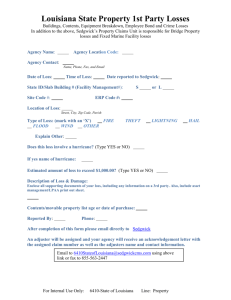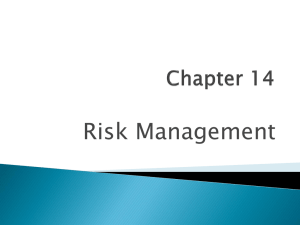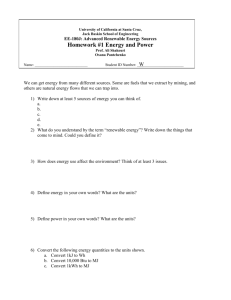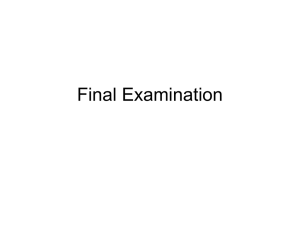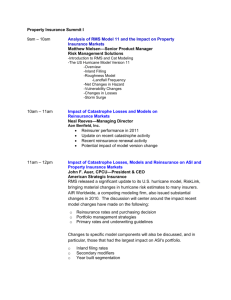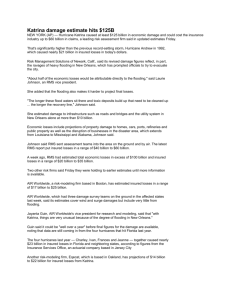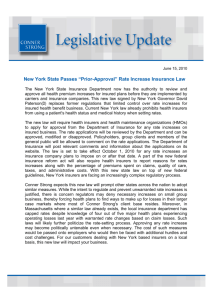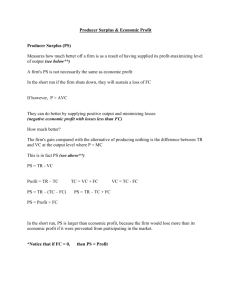Hurricane Sandy
advertisement
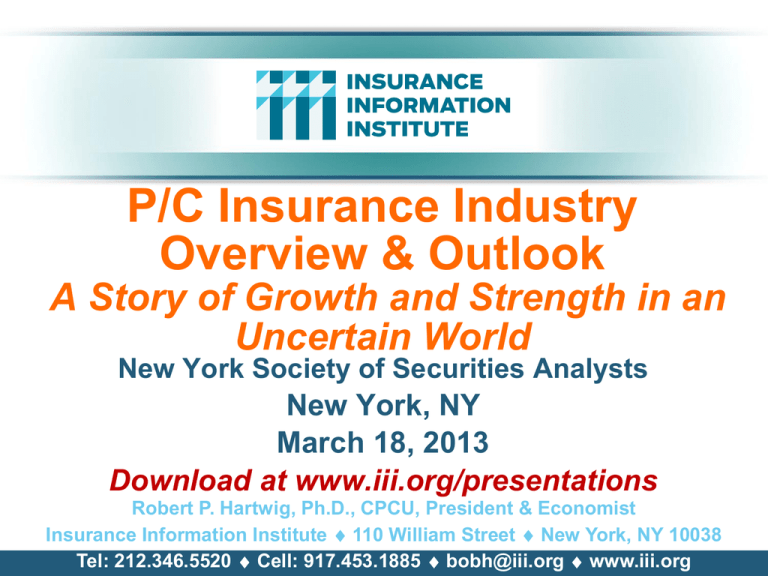
P/C Insurance Industry Overview & Outlook A Story of Growth and Strength in an Uncertain World New York Society of Securities Analysts New York, NY March 18, 2013 Download at www.iii.org/presentations Robert P. Hartwig, Ph.D., CPCU, President & Economist Insurance Information Institute 110 William Street New York, NY 10038 Tel: 212.346.5520 Cell: 917.453.1885 bobh@iii.org www.iii.org P/C Insurance Industry Financial Overview Profit Recovery in 2012 After High CAT Losses; Ultimate Impact of Sandy Still Unclear 2 $26,981 $19,150 $3,043 $28,672 $35,204 $65,777 $44,155 $38,501 $30,029 $20,559 $20,598 $10,870 $3,046 $10,000 $19,316 $20,000 $5,840 $30,000 $14,178 $40,000 $21,865 $50,000 P-C Industry 2012:Q3 profits were up 222% from 2011:Q3, due primarily to lower catastrophe losses $30,773 $60,000 2005 ROE*= 9.6% 2006 ROE = 12.7% 2007 ROE = 10.9% 2008 ROE = 0.1% 2009 ROE = 5.0% 2010 ROE = 6.6% 2011 ROAS1 = 3.5% 2012:Q3 ROAS1 = 6.3% $36,819 $70,000 $24,404 $80,000 $62,496 P/C Net Income After Taxes 1991–2012:Q3 ($ Millions) $0 -$10,000 -$6,970 91 92 93 94 95 96 97 98 99 00 01 02 03 04 05 06 07 08 09 10 11 12:Q3 * ROE figures are GAAP; 1Return on avg. surplus. Excluding Mortgage & Financial Guaranty insurers yields a 6.6% ROAS through 2012:Q3, 4.6% ROAS for 2011, 7.6% for 2010 and 7.4% for 2009. Sources: A.M. Best, ISO, Insurance Information Institute A 100 Combined Ratio Isn’t What It Once Was: Investment Impact on ROEs Combined Ratio / ROE 15.9% 110 A combined ratio of about 100 generates an ROE of ~6.6% in 2012, ~7.5% ROE in 2009/10, 10% in 2005 and 16% in 1979 106.5 14.3% 12.7% 105 100.6 100 100.1 10.9% 100.8 101.2 9.6% 97.5 99.5 95.7 95 7.4% 92.7 8.8% 106.2 101.0 18% 15% 12% 7.9% 9% 4.3% 4.7% 90 3.6% Catastrophes and lower investment income pulled down ROE in 2012 85 6% 3% 0% 80 1978 1979 2003 2005 2006 2007 Combined Ratio 2008 2009 2010 2011 2012E ROE* Combined Ratios Must Be Lower in Today’s Depressed Investment Environment to Generate Risk Appropriate ROEs * 2008 -2012 figures are return on average surplus and exclude mortgage and financial guaranty insurers. 2012:Q3 combined ratio including M&FG insurers is 100.9, 2011 combined ratio including M&FG insurers is 108.2, ROAS = 3.5%. Source: Insurance Information Institute from A.M. Best and ISO data. Profitability Peaks & Troughs in the P/C Insurance Industry, 1975 – 2013F* ROE History suggests next ROE peak will be in 2016-2017 25% 1977:19.0% 1987:17.3% 20% 2006:12.7% 1997:11.6% 15% 2013F 5.8% 9 Years 10% 5% 2012E: 3.6% 0% 1975: 2.4% 1984: 1.8% 1992: 4.5% 2001: -1.2% 75 76 77 78 79 80 81 82 83 84 85 86 87 88 89 90 91 92 93 94 95 96 97 98 99 00 01 02 03 04 05 06 07 08 09 10 11 12 13F -5% *Profitability = P/C insurer ROEs. 2011 figure is an estimate based on ROAS data. Note: Data for 2008-2012 exclude mortgage and financial guaranty insurers. 2012:Q3 ROAS = 6.2% including M&FG. Source: Insurance Information Institute; NAIC, ISO, A.M. Best. The Strength of the Economy Will Influence P/C Insurer Growth Opportunities Growth Will Expand Insurer Exposure Base Across Most Lines 6 1.4% -8.9% 2013 is expected to see initially slow growth, then gradually accelerate throughout the year and into 2014 2000 2001 2002 2003 2004 2005 2006 07:1Q 07:2Q 07:3Q 07:4Q 08:1Q 08:2Q 08:3Q 08:4Q 09:1Q 09:2Q 09:3Q 09:4Q 10:1Q 10:2Q 10:3Q 10:4Q 11:1Q 11:2Q 11:3Q 11:4Q 12:1Q 12:2Q 12:3Q 12:4Q 13:1Q 13:2Q 13:3Q 13:4Q 14:1Q 14:2Q 14:3Q 14:4Q -9% -5.3% -7% -3.7% -5% Recession began in Dec. 2007. Economic toll of credit crunch, housing slump, labor market contraction was severe -1.8% -1% -3% 2.3% 2.2% 2.6% 2.4% 0.1% 2.5% 1.3% 4.1% 2.0% 1.3% 3.1% 0.1% 2.1% 2.0% 2.5% 2.7% 2.6% 2.8% 2.9% 3.0% 1% -0.3% 3% 1.3% 5% The Q4:2008 decline was the steepest since the Q1:1982 drop of 6.8% 1.1% 1.8% 2.5% 3.6% 3.1% 2.7% 0.5% 3.6% 3.0% 1.7% 7% 4.1% Real GDP Growth (%) 5.0% US Real GDP Growth* Demand for Insurance Continues To Be Impacted by Sluggish Economic Conditions, but the Benefits of Even Slow Growth Will Compound and Gradually Benefit the Economy Broadly * Estimates/Forecasts from Blue Chip Economic Indicators. Source: US Department of Commerce, Blue Economic Indicators 3/13; Insurance Information Institute. 7 Auto/Light Truck Sales, 1999-2019F 14.4 12 11 16.2 16.2 16.2 16.2 12.7 11.6 13 New auto/light truck sales fell to the lowest level since the late 1960s. Forecast for 2013-14 is still far below 1999-2007 average of 17 million units, but a robust recovery is well underway. 10.4 14 13.2 15 16.0 16 15.8 16.1 16.5 16.9 16.9 17.1 17.5 16.6 17 17.8 18 17.4 19 15.3 Job growth and improved credit market conditions will boost auto sales in 2013 and beyond (Millions of Units) 10 9 99 00 01 02 03 04 05 06 07 08 09 10 11 12 13F 14F 15F 16F 17F 18F 19F Car/Light Truck Sales Will Continue to Recover from the 2009 Low Point, Bolstering the Auto Insurer Growth and the Manufacturing Sector. Source: U.S. Department of Commerce; Blue Chip Economic Indicators (3/13); Insurance Information Institute. 12 Personal Auto Insurance Direct Written Premiums vs. Recently-Registered Cars % of registered cars under 3 years old 26% 24% 22% In 2004-07 no growth in PP DWP despite strong new car/truck sales 18% $195 $185 $175 $165 New car/truck sales grow to 14-15M/year Average age of registered cars rose as fewer new cars were bought (and insured) 20% $ Billions 4%/yr growth forecast for PP DWP from recovering new car/truck sales 30% 28% Auto Ins Direct Pms $155 $145 $135 16% $125 01 02 03 04 05 06 07 08 09 10 11 12E 13F 14F PP DWP, flat from 2004-2009, is rising again. Conning forecasts growth at 3.5% in 2013 and 4.0% in 2014. Sources: AIPSO Facts (various issues); SNL Financial; Conning Research & Consulting, Property-Casualty Forecast and Analysis, First Quarter 2012; Insurance Information Institute. 13 Monthly Change* in Auto Insurance Prices, 1991–2013* 10% 8% Cyclical peaks in PP Auto tend to occur approximately every 10 years (early 1990s, early 2000s and likely the early 2010s) Pricing peak occurred in late 2010 at 5.3%, falling to 2.8% by Mar. 2012 6% 4% 2% 0% “Hard” markets tend to occur during recessionary periods The Feb. 2013 reading of 5.2% is up from 3.6% a year earlier; Highest since Dec. 2010 -2% '90 '91 '92 '93 '94 '95 '96 '97 '98 '99 '00 '01 '02 '03 '04 '05 '06 '07 '08 '09 '10 '11 '12 '13 *Percentage change from same month in prior year; through Feb. 2013; seasonally adjusted Note: Recessions indicated by gray shaded columns. Sources: US Bureau of Labor Statistics; National Bureau of Economic Research (recession dates); Insurance Information Institutes. 14 New Private Housing Starts, 1990-2019F 1.7 1.5 1.3 1.1 0.9 0.7 0.5 New home starts plunged 72% from 2005-2009; A net annual decline of 1.49 million units, lowest since records began in 1959 1.21 1.35 1.44 1.50 1.51 1.50 1.9 1.00 2.1 0.55 0.59 0.61 0.78 1.19 1.01 1.20 1.29 1.46 1.35 1.48 1.47 1.62 1.64 1.57 1.60 1.71 1.85 1.96 2.07 1.80 1.36 0.91 Job growth, low inventories of existing homes, low mortgage rates and demographics are stimulating new home construction for the first time in years (Millions of Units) 0.3 90 91 92 93 94 95 96 97 98 99 00 01 02 03 04 05 06 07 08 09 10 11 12 13F14F15F16F17F18F19F Homeowners Insurers Are Starting to See Meaningful Exposure Growth for the First Time Since 2005. Commercial Insurers with Construction Risk Exposure, Surety, Workers Comp Also Benefit Source: U.S. Department of Commerce; Blue Chip Economic Indicators (3/13); Insurance Information Institute. 16 Average Premium for Home Insurance Policies** $1,100 $988 $1,000 $945 $909 $880 $900 $804 $800 $822 $830 07 08 $764 $729 $700 $668 $593 $600 $508 $536 $500 $400 00 01 02 03 04 05 06 09 10 11* 12* Countrywide Home Insurance Expenditures Increased by an Estimated 4.0%in 2011 and 4.5% in 2012 * Insurance Information Institute Estimates/Forecasts **Excludes state-run insurers. Source: NAIC, Insurance Information Institute estimates for 2011-2012 based on CPI data and other data. 17 Construction Employment, Jan. 2010—February 2013* 5,850 5,800 5,750 5,650 5,600 5,550 5,500 5,450 5,581 5,700 Construction employment growth accelerated in the second half of 2012. Stronger growth in this key sector is possible in 2013. 5,522 5,542 5,554 5,527 5,512 5,497 5,519 5,499 5,501 5,497 5,468 5,435 5,478 5,485 5,497 5,524 5,530 5,547 5,546 5,583 5,576 5,577 5,612 5,629 5,644 5,640 5,636 5,615 5,622 5,627 5,630 5,633 5,649 5,673 5,711 5,736 5,784 (Thousands) 5,900 Construction for the new $4B Tappan Zee Bridge will create thousands of jobs Jan-10 Feb-10 Mar-10 Apr-10 May-10 Jun-10 Jul-10 Aug-10 Sep-10 Oct-10 Nov-10 Dec-10 Jan-11 Feb-11 Mar-11 Apr-11 May-11 Jun-11 Jul-11 Aug-11 Sep-11 Oct-11 Nov-11 Dec-11 Jan-12 2/30/2 Mar-12 Apr-12 May-12 Jun-12 Jul-12 Aug-12 Sep-12 Oct-12 Nov-12 Dec-12 Jan-13 2/30/2 5,400 *Seasonally adjusted Sources: US Bureau of Labor Statistics at http://data.bls.gov; Insurance Information Institute. 18 Nonfarm Payroll (Wages and Salaries): Quarterly, 2005–2012:Q4 Billions $7,250 Latest (2012:Q4) was $6.96 trillion, a new peak--$708B above 2009 trough $7,000 Prior Peak was 2008:Q1 at $6.60 trillion $6,750 $6,500 Pace of payroll growth accelerated in late 2012 $6,250 $6,000 Growth rates in 2012 Q1:12 over Q4:11: 1.8% Q2 over Q1: 1.4% Q3 over Q2: 0.3% Q4 over Q3: 1.0% Recent trough (2009:Q3) was $6.25 trillion, down 5.3% from prior peak $5,750 Note: Recession indicated by gray shaded column. Data are seasonally adjusted annual rates. Sources: http://research.stlouisfed.org/fred2/series/WASCUR; National Bureau of Economic Research (recession dates); Insurance Information Institute. 12:Q4 12:Q3 12:Q1 12:Q2 11:Q3 11:Q4 11:Q2 10:Q4 11:Q1 10:Q3 10:Q1 10:Q2 09:Q3 09:Q4 09:Q2 08:Q4 09:Q1 08:Q3 08:Q1 08:Q2 07:Q3 07:Q4 07:Q2 06:Q4 07:Q1 06:Q3 06:Q1 06:Q2 05:Q3 05:Q4 05:Q2 05:Q1 $5,500 20 $1.1 $1.51 $1.46 $1.46 $1.37 $1.35 $1.28 $1.24 $1.20 $1.18 $1.17 Commercial lending plunged by 21.2% ($330B) during the financial crisis and ensuing period of tight credit $1.17 $1.18 $1.21 $1.37 $1.43 $1.49 $1.50 $1.49 $1.44 Commercial lending activity is exceeds pre-crisis levels (+29.1% or $340B above mid-2010 trough) $1.27 $1.25 $1.22 $1.16 $1.2 $1.13 $1.3 $1.18 $1.4 $1.30 $1.5 $1.39 $1.6 $1.48 $Trillions $1.42 Commercial & Industrial Loans Outstanding at FDIC-Insured Banks, Quarterly, 2006-2012:Q4* 12:Q4 12:Q3 12:Q1 11:Q3 11:Q1 10:Q3 10:Q1 09:Q3 09:Q1 08:Q3 08:Q1 07:Q3 07:Q1 06:Q3 06:Q1 $1.0 Outstanding Commercial Loan Volume Has Been Growing for Over Two Years and Is Now Nearly Back to Early Recession Levels. Bodes Very Well for the Creation of Current and Future Commercial Insurance Exposures *Latest data as of 3/18/2013. Source: FDIC at http://www2.fdic.gov/qbp/ (Loan Performance spreadsheet); Insurance Information Institute. 21 Value of Construction Put in Place, January 2013 vs. January 2012* Growth (%) Private: +12.2% 25% Public: -3.0% 21.1% 20% 15% 10% 7.1% 7.1% 5% 0.8% 0% -5% -10% Private sector construction activity is up in both the residential and nonresidential segments Public sector construction activity remains depressed -11.7% -15% Total Construction Total Private Residential-Construction Private -2.7% -3.0% NonResidential-Private Total Public Construction ResidentialPublic NonResidential-Public Overall Construction Activity is Up, But Growth Is Entirely in the Private Sector as State/Local Government Budget Woes Continue *seasonally adjusted Source: U.S. Census Bureau, http://www.census.gov/construction/c30/c30index.html ; Insurance Information Institute. 23 ISM Manufacturing Index (Values > 50 Indicate Expansion) 55 50 45 40 51.4 52.5 52.5 51.8 52.2 53.1 54.1 51.9 53.3 54.1 52.5 50.2 50.5 50.7 51.6 51.7 49.9 50.2 53.1 54.2 60 Manufacturing activity expanded in 3 of the past 4 months, but only slightly. The recent trend is basically flat. Jan-10 Feb-10 Mar-10 Apr-10 May-10 Jun-10 Jul-10 Aug-10 Sep-10 Oct-10 Nov-10 Dec-10 Jan-11 Feb-11 Mar-11 Apr-11 May-11 Jun-11 Jul-11 Aug-11 Sep-11 Oct-11 Nov-11 Dec-11 Jan-12 Feb-12 Mar-12 Apr-12 May-12 Jun-12 Jul-12 Aug-12 Sep-12 Oct-12 Nov-12 Dec-12 Jan-13 Feb-13 65 58.3 57.1 60.4 59.6 57.8 55.3 55.1 55.2 55.3 56.9 58.2 58.5 60.8 61.4 59.7 59.7 54.2 55.8 January 2010 through February 2013 The manufacturing sector expanded for 33 of the 38 months from Jan. 2010 through Feb. 2013. The expectation is that this will continue. Source: Institute for Supply Management at http://www.ism.ws/ismreport/mfgrob.cfm; Insurance Information Institute. 26 Dollar Value* of Manufacturers’ Shipments Monthly, Jan. 1992—Jan. 2013 $ Millions $500,000 $400,000 ENERGY INTENSIVE The value of Manufacturing Shipments in Jan. 2013 were up 35% to $481.8B from its May 2009 trough. June figure is only 0.7% below its previous record high in July 2008. $300,000 Ja n92 Ja n93 Ja n94 Ja n95 Ja n96 Ja n97 Ja n98 Ja n99 Ja n00 Ja n 01 Ja n 02 Ja n 03 Ja n 04 Ja n 05 Ja n 06 Ja n 07 Ja n 08 Ja n 09 Ja n 10 Ja n 11 Ja n 1 Ja 2 n 13 $200,000 Monthly shipments are nearly back to peak (in July 2008, 8 months into the recession). Trough in May 2009. Growth from trough to Jan. 2013 was 35%. Manufacturing is an energy intensive activity and growth leads to gains in many commercial exposures: WC, Commercial Auto, Marine, Property and Various Liability Coverages *seasonally adjusted Source: U.S. Census Bureau, Full Report on Manufacturers’ Shipments, Inventories, and Orders, http://www.census.gov/manufacturing/m3/ 27 Jan-10 Feb-10 Mar-10 Apr-10 May-10 Jun-10 Jul-10 Aug-10 Sep-10 Oct-10 Nov-10 Dec-10 Jan-11 Feb-11 Mar-11 Apr-11 May-11 Jun-11 Jul-11 Aug-11 Sep-11 Oct-11 Nov-11 Dec-11 Jan-12 2/30/2 Mar-12 Apr-12 May-12 Jun-12 Jul-12 Aug-12 Sep-12 Oct-12 Nov-12 Dec-12 Jan-13 Feb-13 12,400 12,200 12,000 11,800 11,600 11,460 11,460 11,466 11,497 11,531 11,539 11,558 11,548 11,554 11,555 11,577 11,590 11,624 11,662 11,682 11,707 11,715 11,724 11,747 11,760 11,762 11,770 11,769 11,797 11,841 11,870 11,910 11,920 11,926 11,935 11,957 11,943 11,925 11,931 11,938 11,951 11,963 11,977 Manufacturing Employment, Jan. 2010—February 2013* (Thousands) Manufacturing employment is up by more than 500,000 or 4.5% since Jan. 2010—a surprising source of strength in the economy. Employment in the sector is close to a multi-year high. 11,400 11,200 11,000 *Seasonally adjusted Sources: US Bureau of Labor Statistics at http://data.bls.gov; Insurance Information Institute. 30 ISM Non-Manufacturing Index (Values > 50 Indicate Expansion) January 2010 through February 2013 60 55 50.7 52.7 54.1 54.6 54.8 53.5 53.7 52.8 53.9 54.6 56 57.1 59.4 59.7 56.3 54.4 53.3 53.4 53.8 52.6 52.6 52.6 52.6 53.0 56.8 56.1 55.0 53.7 54.1 52.7 52.9 54.3 55.2 54.8 54.8 55.7 55.2 56.0 65 50 40 Jan-10 Feb-10 Mar-10 Apr-10 May-10 Jun-10 Jul-10 Aug-10 Sep-10 Oct-10 Nov-10 Dec-10 Jan-11 Feb-11 Mar-11 Apr-11 May-11 Jun-11 Jul-11 Aug-11 Sep-11 Oct-11 Nov-11 Dec-11 Jan-12 Feb-12 Mar-12 Apr-12 May-12 Jun-12 Jul-12 Aug-12 Sep-12 Oct-12 Nov-12 Dec-12 Jan-13 Feb-13 45 Optimism among nonmanufacturers is stable and remains expansionary in 2013 Non-manufacturing industries have been expanding and adding jobs. The question is whether this will continue. Source: Institute for Supply Management at http://www.ism.ws/ismreport/nonmfgrob.cfm; Insurance Information Institute. 31 Business Bankruptcy Filings, 1980-2012:Q3 90,000 60,000 50,000 40,000 30,000 20,000 10,000 0 1980-82 1980-87 1990-91 2000-01 2006-09 58.6% 88.7% 10.3% 13.0% 208.9%* 2011 bankruptcies totaled 47,806, down 15.1% from 56,282 in 2010—the second consecutive year of decline. Business bankruptcies more than tripled during the financial crisis. Through Q3:2012, filings were down 15.8% vs. Q3:2011 80 81 82 83 84 85 86 87 88 89 90 91 92 93 94 95 96 97 98 99 00 01 02 03 04 05 06 07 08 09 10 11 12:Q3 70,000 43,694 48,125 80,000 69,300 62,436 64,004 71,277 81,235 82,446 63,853 63,235 64,853 71,549 70,643 62,304 52,374 51,959 53,549 54,027 44,367 37,884 35,472 40,099 38,540 35,037 34,317 39,201 19,695 28,322 43,546 60,837 56,282 47,806 30,620 % Change Surrounding Recessions Significant Exposure Implications for All Commercial Lines as Business Bankruptcies Begin to Decline Sources: American Bankruptcy Institute at http://www.abiworld.org/AM/AMTemplate.cfm?Section=Home&TEMPLATE=/CM/ContentDisplay.cfm&CONTENTID=61633; Insurance Information Institute 32 Private Sector Business Starts, 1993:Q2 – 2012:Q2* 230 220 210 200 190 180 170 Business Starts 2006: 872,000 2007: 843,000 2008: 790,000 2009: 697,000 2010: 742,000 2011: 748,000* 175 186 174 180 186 192 188 187 189 186 190 194 191 199 204 202 195 196 196 206 206 201 192 198 206 206 203 211 205 212 200 205 204 204 197 203 209 201 203 192 192 193 201 204 202 210 212 209 216 220 223 220 220 210 221 212 204 218 209 207 207 199 191 193 172 176 169 184 175 179 188 200 183 187 191 197 193 191 (Thousands) Business starts were up 2.2% to 748,000 in 2011 vs. 2010. In 2012, starts are likely to be up by about 2.7% over 2011 levels. 160 150 93 94 95 96 97 98 99 00 01 02 03 04 05 06 07 08 09 10 11 12 Business Starts Were Down Nearly 20% in the Recession, Holding Back Most Types of Commercial Insurance Exposure, But Are Recovering Slowly * Data through Jun. 30, 2012 are the latest available as of Feb. 6, 2013; Seasonally adjusted. Source: Bureau of Labor Statistics, http://www.bls.gov/news.release/cewbd.t08.htm. 33 12 Industries for the Next 10 Years: Insurance Solutions Needed Health Care Health Sciences Energy (Traditional) Alternative Energy Petrochemical Agriculture Natural Resources Technology (incl. Biotechnology) Many industries are poised for growth, though insurers’ ability to capitalize on these industries varies widely Light Manufacturing Insourced Manufacturing Export-Oriented Industries Shipping (Rail, Marine, Trucking, Pipelines) 35 Hurricane Sandy Summary Sandy Will Become One of the Most Expensive Events in Insurance History 36 Top 12 Most Costly Hurricanes in U.S. History (Insured Losses, 2012 Dollars, $ Billions) 10 of the 12 most costly hurricanes in insurance history occurred over the past 9 years (2004—2012) Hurricane Sandy could become the 3rd costliest hurricane in US insurance history $60 $50 $40 $30 Hurricane Irene became the 12th most expensive hurricane in US history in 2011 $22.0 $20 $10 $5.6 $6.7 $7.8 $8.7 $9.2 $4.4 $5.6 Irene (2011) Jeanne (2004) Frances (2004) Rita (2005) Hugo (1989) Ivan (2004) Charley (2004) $11.1 $48.7 $25.6 $13.4 $0 Wilma (2005) Ike (2008) Sandy* (2012) Andrew (1992) Katrina (2005) *Estimate as of 12/09/12 based on estimates of catastrophe modeling firms and reported losses as of 1/12/13. Estimates range up to $25B. Sources: PCS; Insurance Information Institute inflation adjustments to 2012 dollars using the CPI. 38 Hurricane Sandy: Claim Payments to Policyholders, by State ($ Thousands) $12,000 $10,000 $9,600 $8,000 $6,300 TOTAL = $18.75 BILLION At $9.6B and $6.6B, respectively, NY and NJ suffered, by far, the largest losses from Hurricane Sandy $6,000 $4,000 $2,000 $700 $500 $410 $295 $292 $210 $103 $84 $58 $57 $55 $37 $36 $0 NY NJ PA CT MD VA OH MA RI $13 DE WV NC NH DC ME VT Insurers Will Pay at Least $18.75 Billion to 1.52 Million Policyholders Across 15 States and DC in the Wake of Hurricane Sandy Sources: Catastrophe loss data is for Catastrophe Serial No. 90 (Oct. 28 – 31, 2012) from PCS as of Jan. 18, 2013; Insurance Information Institute . 39 Hurricane Sandy: Number of Claims by Type* Total Claims = 1.52 Million* Commercial , 202,500 , 13% Auto, 250,500 , 16% Sandy is a high HO frequency, (relatively low) severity event (avg. severity <50% Katrina) Hurricane Sandy resulted in an estimated 1.52 million privately insured claims resulting in an estimated $18.75 to $25 billion in insured losses. Hurricane Katrina produced 1.74 million claims and $48.7B in losses (in 2012 $) Homeowner , 1,067,000 , 71% *PCS claim count estimate s as of 1/18/13. Loss estimate represents PCS total ($18.75B) and upper end of range estimates by risk modelers RMS, Eqecat and AIR. All figures exclude losses paid by the NFIP. Source: PCS; AIR, Eqecat, AIR Worldwide; Insurance Information Institute. 40 Hurricane Sandy: Insured Loss by Claim Type* ($ Millions) Total Claim Value = $18.75 Billion* Commercial , $9,024 , 48% Auto, $2,729 , 15% Although Commercial Lines accounted for only 13% of total claims, they account for 48% of all claim dollars paid. In most hurricanes, Commercial Lines accounts for about 1/3 of insured losses. Homeowner , $6,997 , 37% *PCS insured loss estimates as of 1/18/13. Catastrophe modeler estimates range up to $25 billion. All figures exclude losses paid by the NFIP. Source: PCS; Insurance Information Institute. 41 Hurricane Sandy: Loss Distribution by Commercial/Personal Lines and Reinsurance vs. Primary Insurer Personal vs. Commercial Lines* Personal Lines 45% Primary vs. Reinsurer Share** Reinsurance 30% Commercial Lines 55% Primary 70% ~55% of Sandy losses appear to be commercial lines, and ~45% personal, the opposite of the norm for hurricane losses Reinsurers’ share of Sandy losses appears to be in the 30% range, though this is highly preliminary *Fitch Ratings assigns a range of 60-65% commercial and 35-40% personal lines., Hurricane Sandy Update, January 8, 2013. **Source: Insurance Information Institute rough estimate based on company reports as of January 13, 2013. Actual number will vary. 45 Hurricane Sandy: Average Claim Payment by Type of Claim $50,000 $43,056 $45,000 $40,000 $35,000 $30,000 $25,000 Commercial (i.e., business claims) are more expensive because the value of property is often higher as well as the impact of insured business interruption losses The average insured flood loss was 6.5 times larger than the average non-flood insured loss (mostly wind) $20,000 $10,894 $15,000 $10,000 $44,563 $6,558 $5,000 $0 Home* Vehicle NFIP Flood** Commercial Commercial (Business) Claims Were Nearly Seven Times More Expensive than Homeowners Claims; Vehicle Claims Were Unusually Expensive Due to Extensive Flooding *Includes rental and condo policies (excludes NFIP flood). **As of Feb. 20, 2013. Sources: Catastrophe loss data is for Catastrophe Serial No. 90 (Oct. 28 – 31, 2012) from PCS as of Jan. 18, 2013; Insurance Information Institute . 46 U.S. Insured Catastrophe Loss Update 2012 Catastrophe Losses Were Close to “Average” Until Sandy Hit 2011 Was the 5th Most Expensive Year on Record 57 Natural Disasters in the United States, 1980 – 2012 Number of Events (Annual Totals 1980 – 2012) There were 184 natural disaster events in the US in 2012 300 250 Number 200 150 100 41 19 50 121 3 1980 1982 1984 1986 1988 Geophysical (earthquake, tsunami, volcanic activity) Source: MR NatCatSERVICE 1990 1992 1994 1996 1998 2000 Meteorological (storm) Hydrological (flood, mass movement) 2002 2004 2006 2008 2010 2012 Climatological (temperature extremes, drought, wildfire) 60 U.S. Thunderstorm Loss Trends, 1980 – 2012 Hurricanes get all the headlines, but thunderstorms are consistent producers of large scale loss. 2008-2012 are the most expensive years on record. Average thunderstorm losses are up 7 fold since the early 1980s. The 5- year running average loss is up sharply. Source: Property Claims Service, MR NatCatSERVICE Thunderstorm losses in 2012 totaled $14.9 billion, the 2nd highest on record 62 Top 16 Most Costly Disasters in U.S. History (Insured Losses, 2012 Dollars, $ Billions) Hurricane Sandy could become the 4th or 5th costliest event in US insurance history $60 $50 $48.7 $40 $30 Includes Tuscaloosa, AL, tornado Includes Joplin, MO, tornado $22.0 $23.9 $20 $10 $0 $9.2 $11.1 $8.7 $7.8 $7.5 $7.1 $6.7 $4.4 $5.6 $5.6 Irene (2011) Jeanne (2004) Frances (2004) Rita Tornadoes/Tornadoes/ Hugo (2005) T-Storms T-Storms (1989) (2011) (2011) Hurricane Irene became the 12th most expense hurricane in US history in 2011 Ivan (2004) Charley (2004) Wilma (2005) $24.6 $25.6 $13.4 Ike (2008) Sandy* Northridge9/11 Attack Andrew (2012) (1994) (2001) (1992) Katrina (2005) 12 of the 16 Most Expensive Events in US History Have Occurred Over the Past Decade *Estimate as of 12/09/12 based on estimates of catastrophe modeling firms and reported losses as of 1/12/13. Estimates range up to $25B. Sources: PCS; Insurance Information Institute inflation adjustments to 2012 dollars using the CPI. 63 US Insured Catastrophe Losses $7.5 $10.5 $39.0 $29.2 $33.7 $16.3 $7.6 $6.1 $11.6 $14.3 $3.8 $11.0 $12.6 $8.8 $10 $8.0 $20 $4.8 $30 $14.0 $40 $26.4 $37.8 $50 $34.7 $60 $33.1 $70 2012 was likely the second most expensive year ever for insured CAT losses $14.4 $80 $11.5 $73.4 ($ Billions, 2012 Dollars) $0 89 90 91 92 93 94 95 96 97 98 99 00 01 02 03 04 05 06 07 08 09 10 11 12* US CAT Losses in 2012 Will Likely Become the 2nd or 3rd Highest in US History on An Inflation-Adjusted Basis (Pvt Insured). 2011 Losses Were the 5th Highest Record Tornado Losses Caused 2011 CAT Losses to Surge *As of 1/2/13. Includes $20B gross loss estimate for Hurricane Sandy. Note: 2001 figure includes $20.3B for 9/11 losses reported through 12/31/01 ($25.9B 2011 dollars). Includes only business and personal property claims, business interruption and auto claims. Non-prop/BI losses = $12.2B ($15.6B in 2011 dollars.) Sources: Property Claims Service/ISO; Insurance Information Institute. 64 64 Top 16 Most Costly World Insurance Losses, 1970-2012* (Insured Losses, 2012 Dollars, $ Billions) 2012 insured CAT Losses totaled $60B; Economic losses totaled $140B, according to Swiss Re $60 $50 $40 $30 $20 $10 5 of the top 14 most expensive catastrophes in world history have occurred within the past 3 years $48.7 Hurricane Sandy could become the 6th costliest event in global insurance history $11.1 $13.4 $13.4 $9.6 $9.2 $8.7 $8.5 $8.1 $7.8 $38.6 $22.0 $23.9 $24.6 $25.6 $13.4 $0 Hugo (1989) Winter Storm Daria (1991) Chile Quake (2010) Ivan Charley Typhoon Wilma Thailand New Ike Sandy Northridge WTC (2004) (2004) Mirielle (2005) Floods Zealand (2008) (2012)** (1994) Terror (1991) (2011) Quake Attack (2011) (2001) Andrew Japan Katrina (1992) Quake, (2005) Tsunami (2011)** *Figures do not include federally insured flood losses. **Estimate based on PCS value of $18.75B as of 1/18/13 and assumption of upward development based on catastrophe modeler estimates ranging as high as $25B. Sources: Swiss Re sigma 1/2011; Munich Re; Insurance Information Institute research. 65 Homeowners Insurance Catastrophe-Related Claim Frequency and Severity, 1997—2012* Avg. catastrophe claim cost rose approximately 200% from 1997-2011 Cat claim frequency in 2011 was at historic highs and more than double the rate in 1997 *All policy forms combined, countrywide. Source: Insurance Research Council, Trends in Homeowners Insurance Claims, Sept. 2012 from ISO Fast Track data. 68 Combined Ratio Points Associated with Catastrophe Losses: 1960 – 2012* 8.7 9.4 3.4 2012E 2010 2008 1.6 2.6 2.7 2006 1.6 2002 2004 1.6 2000 1.0 1998 1996 3.3 3.3 3.6 2.9 3.3 2.8 1994 5.0 5.4 5.9 8.1 8.8 1990 2.1 2.3 3.0 1.2 1988 1986 1984 1982 1980 1978 1976 1974 1972 1970 1.2 0.4 0.8 1.3 0.3 0.4 0.7 1.5 1.0 0.4 0.4 0.7 1.8 1.1 0.6 1.4 2.0 1.3 2.0 0.5 0.5 0.7 1968 0.4 1966 1962 1964 3.6 1960s: 1.04 1970s: 0.85 1980s: 1.31 1990s: 3.39 2000s: 3.52 2010s: 7.20* 0.8 1.1 1.1 0.1 0.9 1960 10 9 8 7 6 5 4 3 2 1 0 Catastrophe losses as a share of all losses reached a record high in 2012 Avg. CAT Loss Component of the Combined Ratio by Decade 1992 Combined Ratio Points The Catastrophe Loss Component of Private Insurer Losses Has Increased Sharply in Recent Decades Notes: Private carrier losses only. Excludes loss adjustment expenses and reinsurance reinstatement premiums. Figures are adjusted for losses ultimately paid by foreign insurers and reinsurers. Source: ISO (1960-2011); A.M. Best (2012E) Insurance Information Institute. 69 Homeowners Insurance Combined Ratio: 1990–2014F Record tornado activity 158.4 170 160 Hurricane Sandy 106.8 105.5 118.0 122.2 106.7 105.8 116.9 95.7 89.0 90 100.3 94.4 109.3 121.7 111.4 108.2 109.4 112.7 118.4 1 Hurricane Ike 98.2 100 101.0 110 113.6 120 117.7 130 113.0 140 121.7 150 80 90 91 92 93 94 95 96 97 98 99 00 01 02 03 04 05 06 07 08 09 10 11 12F13F14F Homeowners Performance Deteriorated in 2011/12 Due to Large Cat Losses. Extreme Regional Variation Can Be Expected Due to Local Catastrophe Loss Activity Sources: A.M. Best (1990-2013F);Conning (2014F); Insurance Information Institute. 70 Growth Analysis by State and Business Segment Premium Growth Rates Vary Tremendously by State 71 Direct Premiums Written: Total P/C Percent Change by State, 2006-2011* Top 25 States A limited number of states showed strong growth over the past 5 years 71.5 80 60 50 41.8 6.6 6.3 6.1 5.8 4.9 4.7 4.2 3.9 2.4 2.2 2.1 2.1 2.1 0.9 0.9 0.7 0.4 LA AR WI TN IN AK DE NM NC KY SC WA DC MO VT MS 10.5 TX OK MT SD 0 ND 10 MN 11.8 20.8 KS WY 22.6 NE 20 18.2 22.8 30 IA 40 26.4 Pecent change (%) 70 Sources: SNL Financial LC.; Insurance Information Institute. 72 Direct Premiums Written: Total P/C Percent Change by State, 2006-2011* Bottom 25 States Sources: SNL Financial LC.; Insurance Information Institute. NV AZ -19.2 -13.5 -12.0 CA -10.8 WV -11.7 -10.5 NH FL -10.3 -6.0 MI RI MD CO HI -5.8 -4.4 OR ME -4.1 ID -5.2 -3.5 -3.2 -3.1 -2.5 NJ PA CT GA US UT NY VA OH AL -20 IL States with the poorest performing economies also produced the most negative net change in premiums of the past 5 years -15 -25 MA -10 -2.0 -5 -1.6 -1.4 -1.3 -1.1 -0.8 -0.6 Pecent change (%) 0 -0.8 0.4 5 -1.9 NY’s change in premium growth was similar to the US average 73 Labor Market Trends Massive Job Losses Sapped the Economy and Commercial/Personal Lines Exposure, But Trend is Improving 82 Unemployment and Underemployment Rates: Stubbornly High in 2012, But Falling January 2000 through Feb. 2013, Seasonally Adjusted (%) 18 Traditional Unemployment Rate U-3 U-6 went from 8.0% in March 2007 to 17.5% in October 2009; Stood at 14.3% in Feb. 2013 Unemployment + Underemployment Rate U-6 16 Recession ended in November 2001 14 12 Unemployment kept rising for 19 more months Recession began in December 2007 Unemployment stood at 7.7% in Feb. 2013— lowest in 4 years. 10 Unemployment peaked at 10.1% in October 2009, highest monthly rate since 1983. 8 6 4 2 Jan 00 Jan 01 Jan 02 Jan 03 Jan 04 Jan 05 Jan 06 Jan 07 Jan 08 Jan 09 Jan 10 Jan 11 Jan 12 Jan 13 Peak rate in the last 30 years: 10.8% in November December 1982 Stubbornly high unemployment and underemployment constrain overall economic growth, but the job market is now clearly improving Source: US Bureau of Labor Statistics; Insurance Information Institute. 83 (600) (800) (1,000) -786 -701 -821 -692 -812 -821 Monthly Losses in Dec. 08–Mar. 09 Were the Largest in the Post-WW II Period -442 -429 -484 (400) -167 -282 -222 -162 -233 -288 -222 -219 -203 -267 -269 (200) -114 -105 -17 -26 -34 -79 66 227 168 123 400 111 170 102 94 103 129 113 188 154 114 80 243 223 303 183 177 206 129 256 174 197 249 323 265 208 120 152 78 177 131 118 217 256 224 140 246 24 68 74 51 2 1 0 50 54 200 Jan-07 Feb-07 Mar-07 Apr-07 May-07 Jun-07 Jul-07 Aug-07 Sep-07 Oct-07 Nov-07 Dec-07 Jan-08 Feb-08 Mar-08 Apr-08 May-08 Jun-08 Jul-08 Aug-08 Sep-08 Oct-08 Nov-08 Dec-08 Jan-09 Feb-09 Mar-09 Apr-09 May-09 Jun-09 Jul-09 Aug-09 Sep-09 Oct-09 Nov-09 Dec-09 Jan-10 Feb-10 Mar-10 Apr-10 May-10 Jun-10 Jul-10 Aug-10 Sep-10 Oct-10 Nov-10 Dec-10 Jan-11 Feb-11 Mar-11 Apr-11 May-11 Jun-11 Jul-11 Aug-11 Sep-11 Oct-11 Nov-11 Dec-11 Jan-12 Feb-12 Mar-12 Apr-12 May-12 Jun-12 Jul-12 Aug-12 Sep-12 Oct-12 Nov-12 Dec-12 Jan-13 Feb-13 Monthly Change in Private Employment January 2007 through Feb. 2013 (Thousands) Jobs Created 2012: 2.247 Mill 2011: 2.420 Mill 2010: 1.235 Mill Source: US Bureau of Labor Statistics: http://www.bls.gov/ces/home.htm; Insurance Information Institute 246,000 private sector jobs were created in February Private Employers Added 6.31million Jobs Since Jan. 2010 After Having Shed 4.98 Million Jobs in 2009 and 3.80 Million in 2008 (State and Local Governments Have Shed Hundreds of Thousands of Jobs) 84 Cumulative Change in Private Sector Employment: Jan. 2010—Feb. 2013 0.068 0.238 0.340 0.434 0.537 0.666 0.779 0.967 1.121 1.235 1.315 1.558 1.781 2.084 2.267 2.444 2.650 2.779 3.035 3.209 3.406 3.655 3.978 4.243 4.451 4.571 4.723 4.801 4.978 5.109 5.227 5.444 5.700 5.924 6.064 6.310 January 2010 through February 2013* (Millions) 7.0 Job gains and pay increases have added more than $600 billion to payrolls since Jan. 2010 6.0 4.0 3.0 Feb-13 Jan-13 Dec-12 Nov-12 Oct-12 Sep-12 Aug-12 Jul-12 Jun-12 May-12 Apr-12 Mar-12 Feb-12 Jan-12 Dec-11 Nov-11 Oct-11 Sep-11 Aug-11 Jul-11 Jun-11 May-11 Apr-11 Mar-11 Feb-11 Jan-11 Dec-10 Nov-10 Oct-10 Sep-10 Aug-10 Jul-10 Jun-10 May-10 Feb-10 -0.043 -1.0 -0.017 0.0 Jan-10 1.0 Apr-10 Cumulative job gains through Feb. 2013 totaled 6.31 million 2.0 Mar-10 Millions 5.0 Private Employers Added 6.31million Jobs Since Jan. 2010 After Having Shed 4.98 Million Jobs in 2009 and 3.80 Million in 2008 (State and Local Governments Have Shed Hundreds of Thousands of Jobs) Source: US Bureau of Labor Statistics: http://www.bls.gov/ces/home.htm; Insurance Information Institute 86 Cumulative Change in Government Employment: Jan. 2010—Feb. 2013 Government at all levels has shed more than half a million jobs since Jan. 2010 even as private employers created 6.31 million jobs, though losses may now be ending. January 2010 through Feb. 2013* (Millions) 511 -68 Feb-13 Jan-13 Dec-12 Nov-12 Oct-12 Sep-12 Aug-12 Jul-12 Jun-12 May-12 Apr-12 Mar-12 Dec-11 Nov-11 Oct-11 Sep-11 Aug-11 Jul-11 Jun-11 May-11 Apr-11 Mar-11 Feb-11 Jan-11 Dec-10 Nov-10 -224 -184 -194 -213 -224 -271 -289 -288 -356 -324 -452 -449 -480 -488 -511 -530 -542 -536 -539 -547 -574 -565 -589 -555 -535 -592 -601 -606 -627 -637 Oct-10 Aug-10 Jul-10 Jun-10 May-10 Apr-10 Mar-10 -800 Jan-10 -600 Feb-10 Temporary Census hiring distorted 2010 figures -400 Cumulative job losses through Feb. 2013 totaled 637,000 Sep-10 -200 Feb-12 -10 4 0 33 92 200 98 287 400 Jan-12 600 Governments at All Levels are Under Severe Fiscal Strain As Tax Receipts Plunged and Pension Obligations Soared During the Financial Crisis: Sequestration Will Add to this Toll Source: US Bureau of Labor Statistics http://www.bls.gov/data/#employment; Insurance Information Institute 87 Jan-10 Feb-10 Mar-10 Apr-10 May-10 Jun-10 Jul-10 Aug-10 Sep-10 Oct-10 Nov-10 Dec-10 Jan-11 Feb-11 Mar-11 Apr-11 May-11 Jun-11 Jul-11 Aug-11 Sep-11 Oct-11 Nov-11 Dec-11 Jan-12 2/30/2 Mar-12 Apr-12 May-12 Jun-12 Jul-12 Aug-12 Sep-12 Oct-12 Nov-12 Dec-12 Jan-13 Feb-10 200 195 190 185 180 175 170 165 160 156.4 156.4 156.7 157.6 158.7 157.8 158.0 159.5 160.0 161.5 161.2 161.2 163.1 164.4 166.6 169.3 170.1 171.0 172.5 173.6 176.3 178.2 178.5 180.9 181.9 183.1 184.8 185.2 185.7 186.8 187.6 188.0 188.0 188.2 190.0 191.7 192.2 193.3 Oil & Gas Extraction Employment, Jan. 2010—February 2013* (Thousands) Oil and gas extraction employment is up 24.4% since Jan. 2010 as the energy sector booms. Domestic energy production is essential to any robust economic recovery in the US. 155 150 *Seasonally adjusted Sources: US Bureau of Labor Statistics at http://data.bls.gov; Insurance Information Institute. 91 Payroll vs. Workers Comp Net Written Premiums, 1990-2012E Payroll Base* $Billions $7,000 7/90-3/91 $6,000 $5,000 $4,000 $3,000 WC NWP $Billions Wage & Salary Disbursements 3/01-11/01 WC NPW 12/07-6/09 WC premium volume dropped two years before the recession began +9% in 2012E $50 $45 $40 WC net premiums written were down $14B or 29.3% to $33.8B in 2010 after peaking at $47.8B in 2005 $2,000 $35 $30 $25 90 91 92 93 94 95 96 97 98 99 00 01 02 03 04 05 06 07 08 09 10 11 12* Continued Payroll Growth and Rate Increases Suggest WC NWP Will Grow Again in 2012; +7.9% Growth in 2011 Was the First Gain Since 2005 *Private employment; Shaded areas indicate recessions. WC premiums for 2012 are I.I.I. estimate based YTD 2012 actuals. Sources: NBER (recessions); Federal Reserve Bank of St. Louis at http://research.stlouisfed.org/fred2/series/WASCUR ; NCCI; I.I.I. 95 The BIG Question: Where Is the Market Heading? Catastrophes and Other Factors Are Pressuring Insurance Markets New Factor: Record Low Interest Rates Are Contributing to Underwriting and Pricing Pressures 96 INVESTMENTS: THE NEW REALITY Investment Performance is a Key Driver of Profitability Depressed Yields Will Necessarily Influence Underwriting & Pricing 97 Property/Casualty Insurance Industry Investment Income: 2000–2012E1 ($ Billions) $60 $54.6 $52.3 $50 $40 $51.2 $49.5 $47.1 $38.9 $38.7 $37.1 $36.7 01 02 $39.6 $47.6 $49.0 $46.8 Investment earnings in 2012 were running 14% below their 2007 pre-crisis peak $30 00 03 04 05 06 07 08 09 10 11 12E Investment Income Fell in 2012 Due to Persistently Low Interest Rates, Putting Additional Pressure on (Re) Insurance Pricing 1 Investment gains consist primarily of interest and stock dividends. *2012F is based on annualized 9M:2012 actual figure of $35.131B. Sources: ISO; Insurance Information Institute. Property/Casualty Insurance Industry Investment Gain: 1994–2012F1 ($ Billions) $70 $64.0 $58.0 $60 $52.3 $55.7 $51.9 $53.4 $56.2 $50.8 10 11 12F $48.9 $47.2 $50 $59.4 $56.9 $45.3 $44.4 $42.8 $40 $35.4 $39.2 $36.0 $31.7 $30 $20 Investment gains in 2012 are running approximately 20% below their pre-crisis peak $10 $0 94 95 96 97 98 99 00 01 02 03 04 05* 06 07 08 09 Investment Gains Are Slipping in 2012 as Low Interest Rates Reduce Investment Income and Lower Realized Investment Gains; The Financial Crisis Caused Investment Gains to Fall by 50% in 2008 1 Investment gains consist primarily of interest, stock dividends and realized capital gains and losses. * 2005 figure includes special one-time dividend of $3.2B; 2012F figure is III estimate based on annualized actual 9M:2012 result of $38.089B. Sources: ISO; Insurance Information Institute. Average Maturity of Bonds Held by US P/C Insurers, 2006—2011* Average Maturity (Years) The average bond maturity is down by a full year between 2007 and 2011 8.0 7.5 7.32 7.46 7.30 6.89 7.0 6.53 6.45 2010 2011 6.5 6.0 5.5 5.0 2006 2007 2008 2009 Falling Average Maturity (and Duration) of the P/C Industry’s Bond Portfolio is Contributing to the Drop in Investment Income Along With Lower Yields *Year-end figures. Latest available. Sources: Insurance Information Institute calculations based on A.M. Best data. 104 Distribution of Bond Maturities, P/C Insurance Industry, 2006-2011 2011 15.2% 41.4% 2010 16.3% 39.5% 2009 16.2% 2008 15.7% 2007 15.2% 30.0% 2006 16.0% 29.5% 0% 36.2% 32.4% 20% 26.8% 26.7% 28.7% 31.2% 40% 10.3% 6.3% 11.1% 6.4% 11.7% 7.3% 12.7% 8.1% 33.8% 12.9% 8.1% 34.1% 13.1% 7.4% 60% 80% Under 1 year 1-5 years 5-10 years 10-20 years over 20 years 100% The main shift over these 6 years has been from bonds with 5-10 years of maturity to bonds with 1-5 years of maturity. The industry also slightly trimmed it holdings of bonds in the 10-20-year maturity category and bonds in the longest-maturity category. Sources: A.M. Best; Insurance Information Institute. 105 Reduction in Combined Ratio Necessary to Offset 1% Decline in Investment Yield to Maintain Constant ROE, by Line* s ne i L -5.7% -5.2% -4.3% -3.7% -3.3% -3.3% -3.1% -2.1% -1.9% -3.6% -2.0% -1.8% 0% -1% -2% -3% -4% -5% -6% -7% -8% -1.8% s ty l e e o p t r a s n i a ro p l Li y rc Su Au s o t P C a / al r e l s s n y n t a t P u M m m m m li P di so s pl rra d e m m m m r r r t e C a e d o o r o o Pe Pv Pe C C C C C Fi W Su M W to u A R a ur s n ei ** e nc -7.3% Lower Investment Earnings Place a Greater Burden on Underwriting and Pricing Discipline *Based on 2008 Invested Assets and Earned Premiums **US domestic reinsurance only Source: A.M. Best; Insurance Information Institute. 107 1. UNDERWRITING Underwriting Losses in 2011 and 2012 Are Elevated by High Catastrophe Losses 108 P/C Insurance Industry Combined Ratio, 2001–2012:Q3* Heavy Use of Reinsurance Lowered Net Losses As Recently as 2001, Insurers Paid Out Nearly $1.16 for Every $1 in Earned Premiums Relatively Low CAT Losses, Reserve Releases Relatively Low CAT Losses, Reserve Releases 120 115.8 110 Best Combined Ratio Since 1949 (87.6) 107.5 Cyclical Deterioration Higher CAT Losses, Shrinking Reserve Releases, Toll of Soft Market Avg. CAT Losses, More Reserve Releases 106.4 101.0 100.8 100.1 99.3 98.4 100 100.8 Lower CAT Losses Before Sandy 100.0 95.7 92.6 90 2001 2002 2003 2004 2005 2006 2007 2008 2009 2010 2011* 2012:Q3 * Excludes Mortgage & Financial Guaranty insurers 2008--2012. Including M&FG, 2008=105.1, 2009=100.7, 2010=102.4, 2011=108.2; 2012:Q3=100.0. Sources: A.M. Best, ISO. 109 Financial Strength & Underwriting Cyclical Pattern is P-C Impairment History is Directly Tied to Underwriting, Reserving & Pricing 114 P/C Insurer Impairments, 1969–2012 Impairments among P/C insurers remain infrequent 0 18 18 14 15 16 19 21 34 35 31 12 16 18 19 29 5 9 13 12 9 9 11 7 8 69 70 71 72 73 74 75 76 77 78 79 80 81 82 83 84 85 86 87 88 89 90 91 92 93 94 95 96 97 98 99 00 01 02 03 04 05 06 07 08 09 10 11 12 10 15 12 20 16 14 13 19 30 31 34 34 40 36 41 50 49 50 47 49 50 48 55 60 60 58 70 The Number of Impairments Varies Significantly Over the P/C Insurance Cycle, With Peaks Occurring Well into Hard Markets Source: A.M. Best Special Report “1969-2011 Impairment Review,” June 2012 and March 6, 2013 update; Insurance Info. Institute. 115 100.2 98.5 99.6 101.9 101.0 101.3 100.3 98.3 95.5 95.1 98.4 101.1 101.0 101.3 104.2 94.3 95 99.5 100 101.3 105 101.7 110 103.5 109.5 115 107.9 Private Passenger Auto Combined Ratio: 1993–2014F 90 85 80 93 94 95 96 97 98 99 00 01 02 03 04 05 06 07 08 09 10 11 12F 13F 14F Private Passenger Auto Accounts for 34% of Industry Premiums and Remains the Profit Juggernaut of the P/C Insurance Industry Sources: A.M. Best (1990-2013F);Conning (2014F); Insurance Information Institute. 121 Homeowners Insurance Combined Ratio: 1990–2014F Record tornado activity 158.4 170 160 Hurricane Sandy 106.8 105.5 118.0 122.2 106.7 105.8 116.9 95.7 89.0 90 100.3 94.4 109.3 121.7 111.4 108.2 109.4 112.7 118.4 1 Hurricane Ike 98.2 100 101.0 110 113.6 120 117.7 130 113.0 140 121.7 150 80 90 91 92 93 94 95 96 97 98 99 00 01 02 03 04 05 06 07 08 09 10 11 12F13F14F Homeowners Performance Deteriorated in 2011/12 Due to Large Cat Losses. Extreme Regional Variation Can Be Expected Due to Local Catastrophe Loss Activity Sources: A.M. Best (1990-2013F);Conning (2014F); Insurance Information Institute. 122 Commercial Lines Combined Ratio, 1990-2013F* Commercial Lines Combined Ratio 125 122.3 118.8 120 115 110 Commercial lines underwriting performance in 2012 was the worst since 2002 due to heavy impact from Sandy 112.5 110.2 109.4 112.3 111.1 109.7 110.2 109.5 110.2 109.0 107.6 106.7 105.4 104.2 104.1 105 102.5 102.0 102.9 102.1 98.9 100 95 93.6 91.1 *2007-2013F figures exclude mortgage and financial guaranty segments. Source: A.M. Best; Insurance Information Institute 13F 12F 11 10 09 08 07 06 05 04 03 02 01 00 99 98 97 96 95 94 93 92 91 90 90 125 111.0 115.0 117.3 116.9 116.8 110.6 104.5 103.5 102.7 105.1 108.6 101.0 98.5 100 100.0 105 97.0 110 102.0 115 107.0 120 112.6 115.3 125 118.2 130 121.7 Workers Compensation Combined Ratio: 1994–2014F 95 90 85 80 94 95 96 97 98 99 00 01 02 03 04 05 06 07 08 09 10 11 12E 13F 14F Workers Comp Results Should Begin to Improve in 2013. Underwriting Results Deteriorated Markedly from 20072012 and Were the Worst They Had Been in a Decade. Sources: A.M. Best (1994-2013F); Insurance Information Institute (2014F). 133 2. SURPLUS/CAPITAL/CAPACITY How Will Large Catastrophe Losses Impact Capacity? 143 Policyholder Surplus, 2006:Q4–2012:Q3 ($ Billions) Drop due to near-record 2011 CAT losses 2007:Q3 Pre-Crisis Peak $583.5 $566.5 $580 $559.2 $560 $544.8 $540.7 $530.5 $540 $520 $500 $480 $460 $440 $521.8$517.9 $515.6 $512.8 $505.0 $496.6 $487.1 $478.5 The Industry now has $1 of surplus for every $0.80 of NPW, close to the strongest claims-paying status in its history. $570.7 $567.8 $559.1 $550.3 $538.6 $511.5 $490.8 $463.0 $455.6 $437.1 Surplus as of 9/30/12 was up $12.8B or 2.2% from the previous record high of $570.7B set as of 3/31/12. $420 06:Q4 07:Q1 07:Q2 07:Q3 07:Q4 08:Q1 08:Q2 08:Q3 08:Q4 09:Q1 09:Q2 09:Q3 09:Q4 10:Q1 10:Q2 10:Q3 10:Q4 11:Q1 11:Q2 11:Q3 11:Q4 12:Q1 12:Q2 12:Q3 *Includes $22.5B of paid-in capital from a holding company parent for one insurer’s investment in a noninsurance business in early 2010. Sources: ISO, A.M .Best. The P/C Insurance Industry Both Entered and Emerged from the 2012 Hurricane Season Very Strong Financially. There is No Insurance Industry “Fiscal Cliff” 145 3. REINSURANCE MARKET CONDITIONS Record Global Catastrophes Activity is Pressuring Pricing 146 Regional Property Catastrophe Rate on Line Index, 1990—2013 (as of January 1) Property-Cat reinsurance pricing was up in the US as of 1/1/13 but was down in Europe/UK Sources: Guy Carpenter; Insurance Information Institute. 148 4. RENEWED PRICING DISCIPLINE Evidence of a Broad and Sustained Shift in Pricing 149 Net Premium Growth: Annual Change, 1971—2012E (Percent) 1975-78 1984-87 25% 2000-03 Net Written Premiums Fell 0.7% in 2007 (First Decline Since 1943) by 2.0% in 2008, and 4.2% in 2009, the First 3Year Decline Since 1930-33. 20% 15% 2012E growth was +4.9% 10% 5% 0% 71 72 73 74 75 76 77 78 79 80 81 82 83 84 85 86 87 88 89 90 91 92 93 94 95 96 97 98 99 00 01 02 03 04 05 06 07 08 09 10 11 12 -5% Shaded areas denote “hard market” periods Sources: A.M. Best (historical and forecast), ISO, Insurance Information Institute. 151 Average Commercial Rate Change, All Lines, (1Q:2004–4Q:2012) (Percent) 4% -1% -6% -11% -16% -0.1% -3.2% -5.9% -7.0% -9.4% -9.7% -8.2% -4.6% -2.7% -3.0% -5.3% -9.6% -11.3% -11.8% -13.3% -12.0% -13.5% -12.9% -11.0% -6.4% -5.1% -4.9% -5.8% -5.6% -5.3% -6.4% -5.2% -5.4% -2.9% -0.1% 0.9% 2.7% 4.4% 4.3% 3.9% 5.0% 9% Pricing as of Q4:2012 was positive for the 6th consecutive quarter. Gains are likely to continue through 2013. Q2 2011 marked the last of 30th consecutive quarter of price declines 1Q04 2Q04 3Q04 4Q04 1Q05 2Q05 3Q05 4Q05 1Q06 2Q06 3Q06 4Q06 1Q07 2Q07 3Q07 4Q07 1Q08 2Q08 3Q08 4Q08 1Q09 2Q09 3Q09 4Q09 1Q10 2Q10 3Q10 4Q10 1Q11 2Q11 3Q11 4Q11 1Q12 2Q12 3Q12 4Q12 KRW Effect Note: CIAB data cited here are based on a survey. Rate changes earned by individual insurers can and do vary, potentially substantially. Source: Council of Insurance Agents & Brokers; Insurance Information Institute 154 Change in Commercial Rate Renewals, by Line: 2012:Q4 Percentage Change (%) 9.0% 3.4% 3.5% 3.4% General Liability Commercial Auto Umbrella Commercial Auto 4.4% Construction 3.3% 4.4% EPL 3.2% Business Interruption 5.7% 4.9% Workers Comp Commercial Property D&O 1.3% Surety 10.0% 9.0% 8.0% 7.0% 6.0% 5.0% 4.0% 3.0% 2.0% 1.0% 0.0% Workers Comp rate increases are large than any other line, followed by Property lines Major Commercial Lines Renewed Uniformly Upward in Q4:2012 for the Sixth Consecutive Quarter; Property Lines & Workers Comp Leading the Way; Cat Losses and Low Interest Rates Provide Momentum Going Forward Note: CIAB data cited here are based on a survey. Rate changes earned by individual insurers can and do vary, potentially substantially. 159 Source: Council of Insurance Agents and Brokers; Insurance Information Institute. Insurance Information Institute Online: www.iii.org Thank you for your time and your attention! Twitter: twitter.com/bob_hartwig Download at: www.iii.org/presentations 168
